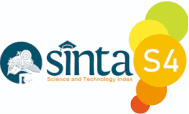ANALISIS MORFOLOGI BENTUK PASIF BAHASA JAWA BANYUMAS
Abstract
Morphology as a part of syntax has always been interesting topic to discuss in a study of linguistics. One interesting phenomeneon in morphology can be found here is the changes of words in the local Banyumas dialects known as “Ngapak”. The changes are different from the Standart Language of Java found in Solo or Jogjakarta.The results of the study showed that in the local language of Banyumas, (1) There are three different prefixes; /tek-/, /kok-/, and /di-/, which constitute passive meaning. These prefixes are commonly used in daily interactions of Banyumas citizens. (2) These passive prefiexes can be meant active in Banyumas. Prefix /tek-/ added in a word can be subtituted by , /kok-/, or /di-/, but if prefix /tek-/ cannot be added, the other two passive prefixes cannot be added either. (3) There four basic forms in its central constituent, namely verbs, nouns, adjectives and numbers.
Key words: Morphology, passive marker prefix, Banyumas dialects.
Full Text:
PDF (Bahasa Indonesia)References
Arifin, S., Suwadji, Gina, Wibowo, S. 1999. Kalimat Pasif dalam Bahasa Jawa. Pusat Pembinaan dan Pengembangan Bahasa: Jakarta
Kridalaksana, Harimurti. 2009. Pembentukan Kata dalam Bahasa Indonesia. Jakarta: Gramedia.
Ramlan. 2009. Morfologi Suatu Tinjauan Deskriptif. Yogyakarta: CV Karyono.
Samsuri. 1985. Analisis Bahasa. Jakarta: Erlangga.
Sudaryanto. 1991. Tata Bahasa Baku Bahasa Jawa. Duta Wacana University Press.
Verhaar, J. W. M. 1984. Pengantar Linguistik I. Yogyakarta: Gadjah Mada University Press.
DOI: https://doi.org/10.32528/bb.v1i1.74
Refbacks
- There are currently no refbacks.
Copyright (c) 2016 BELAJAR BAHASA
Address:Jl. Karimata No. 49 Jember-Jawa Timur-Indonesia
Phone & Fax:(0331)336728 | 337957
Email:belajarbahasa@unmuhjember.ac.id









